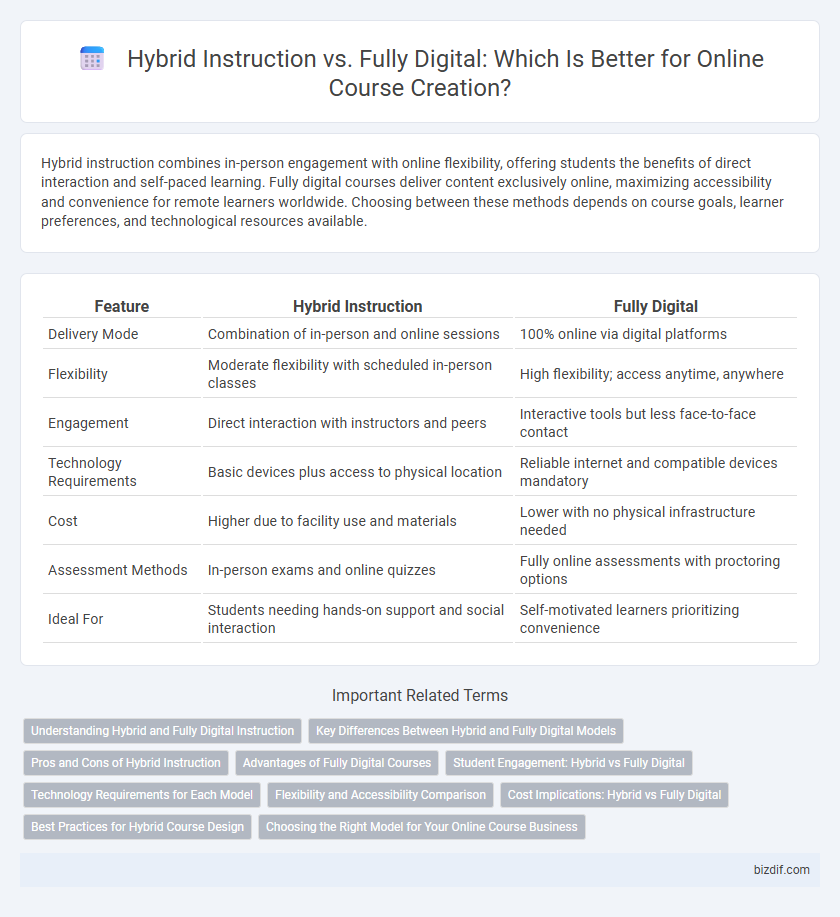Hybrid instruction combines in-person engagement with online flexibility, offering students the benefits of direct interaction and self-paced learning. Fully digital courses deliver content exclusively online, maximizing accessibility and convenience for remote learners worldwide. Choosing between these methods depends on course goals, learner preferences, and technological resources available.
Table of Comparison
| Feature | Hybrid Instruction | Fully Digital |
|---|---|---|
| Delivery Mode | Combination of in-person and online sessions | 100% online via digital platforms |
| Flexibility | Moderate flexibility with scheduled in-person classes | High flexibility; access anytime, anywhere |
| Engagement | Direct interaction with instructors and peers | Interactive tools but less face-to-face contact |
| Technology Requirements | Basic devices plus access to physical location | Reliable internet and compatible devices mandatory |
| Cost | Higher due to facility use and materials | Lower with no physical infrastructure needed |
| Assessment Methods | In-person exams and online quizzes | Fully online assessments with proctoring options |
| Ideal For | Students needing hands-on support and social interaction | Self-motivated learners prioritizing convenience |
Understanding Hybrid and Fully Digital Instruction
Hybrid instruction combines face-to-face classroom experiences with online learning components, enhancing flexibility and engagement through real-time interaction and digital resources. Fully digital instruction delivers all course content through online platforms, enabling self-paced learning and broader accessibility without physical location constraints. Understanding the distinct benefits and challenges of hybrid versus fully digital instruction helps educators design effective, learner-centered online courses that maximize participation and knowledge retention.
Key Differences Between Hybrid and Fully Digital Models
Hybrid instruction blends face-to-face classroom interaction with online learning, allowing students to benefit from real-time engagement and flexible digital resources. Fully digital models rely entirely on internet-based platforms, providing learners access to course materials, assessments, and collaboration tools without physical presence. The key differences lie in the level of personal interaction, technological dependency, and adaptability to diverse learning environments.
Pros and Cons of Hybrid Instruction
Hybrid instruction combines in-person and online learning, offering flexibility and enhanced engagement by accommodating diverse learning styles and schedules. It allows real-time interaction and immediate feedback while leveraging digital resources, but may face challenges such as inconsistent student participation and technological barriers. Balancing physical presence with virtual components requires robust planning and infrastructure to maximize the benefits of both formats.
Advantages of Fully Digital Courses
Fully digital courses offer unmatched flexibility, allowing learners to access content anytime and anywhere, which enhances engagement and retention. They support scalable delivery, accommodating a vast number of students without geographic limitations or physical space constraints. Advanced analytics in fully digital platforms provide educators with real-time data on student performance and behavior, enabling personalized learning experiences and continuous course improvement.
Student Engagement: Hybrid vs Fully Digital
Hybrid instruction boosts student engagement by combining face-to-face interactions with online flexibility, fostering active participation through diverse learning modalities. Fully digital courses rely heavily on multimedia content and interactive platforms but may face challenges in maintaining sustained student motivation and real-time feedback. Data shows hybrid learners often report higher satisfaction and engagement levels compared to those in fully digital environments.
Technology Requirements for Each Model
Hybrid instruction demands robust classroom technology integration such as smartboards, high-quality cameras, and reliable Wi-Fi to facilitate simultaneous in-person and online learning. Fully digital courses rely heavily on advanced learning management systems (LMS), video conferencing platforms, and cloud-based collaboration tools to support remote student engagement and content delivery. Both models require secure data storage and cybersecurity measures, but fully digital instruction places greater emphasis on scalable server infrastructure and continuous software updates.
Flexibility and Accessibility Comparison
Hybrid instruction combines face-to-face sessions with online components, offering greater flexibility by allowing learners to engage with materials both on campus and remotely, accommodating diverse schedules. Fully digital courses maximize accessibility by enabling learners to participate from any location with internet access, removing geographical and time constraints entirely. Both modes enhance flexibility but fully digital formats provide the highest level of accessibility for global and non-traditional students.
Cost Implications: Hybrid vs Fully Digital
Hybrid instruction incurs higher costs due to the need for physical classroom space, on-site staff, and maintenance, while fully digital courses predominantly require investment in platform development, software licenses, and digital content creation. Expenses related to technology infrastructure, such as Learning Management Systems (LMS) and video hosting, drive costs in fully digital models but enable scalability and broader reach compared to limited hybrid class sizes. Budget planning must account for ongoing costs like IT support and updates in fully digital environments versus facility and equipment expenses inherent to hybrid instruction.
Best Practices for Hybrid Course Design
Effective hybrid course design integrates synchronous face-to-face sessions with asynchronous digital content, ensuring flexibility and engagement for diverse learners. Leveraging interactive tools such as discussion forums, video lectures, and real-time quizzes enhances student participation and fosters a collaborative learning environment. Best practices emphasize clear communication, consistent scheduling, and balanced workload distribution to optimize both in-person and online learning experiences.
Choosing the Right Model for Your Online Course Business
Hybrid instruction combines in-person engagement with online flexibility, offering a balanced approach that caters to diverse learning preferences and increases student retention. Fully digital courses provide scalability and accessibility, allowing businesses to reach a global audience with lower overhead costs and streamlined content delivery. Selecting the appropriate model depends on target audience needs, resource availability, and desired interaction levels to maximize course effectiveness and business growth.
Hybrid instruction vs Fully digital Infographic

 bizdif.com
bizdif.com